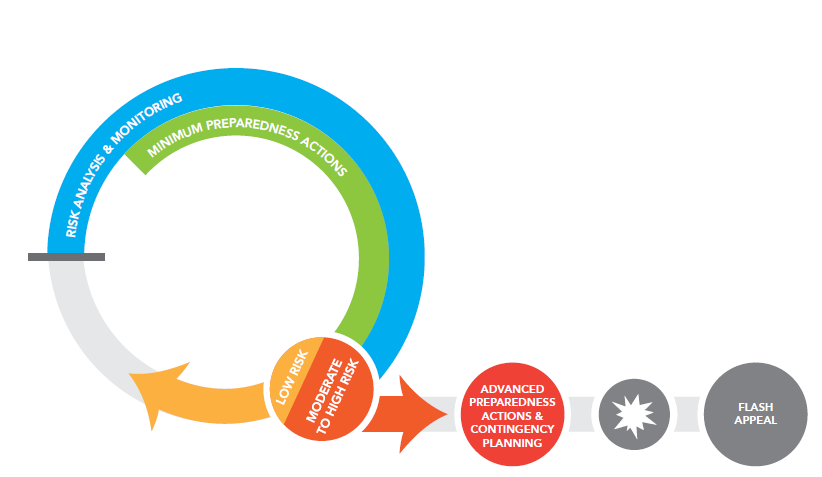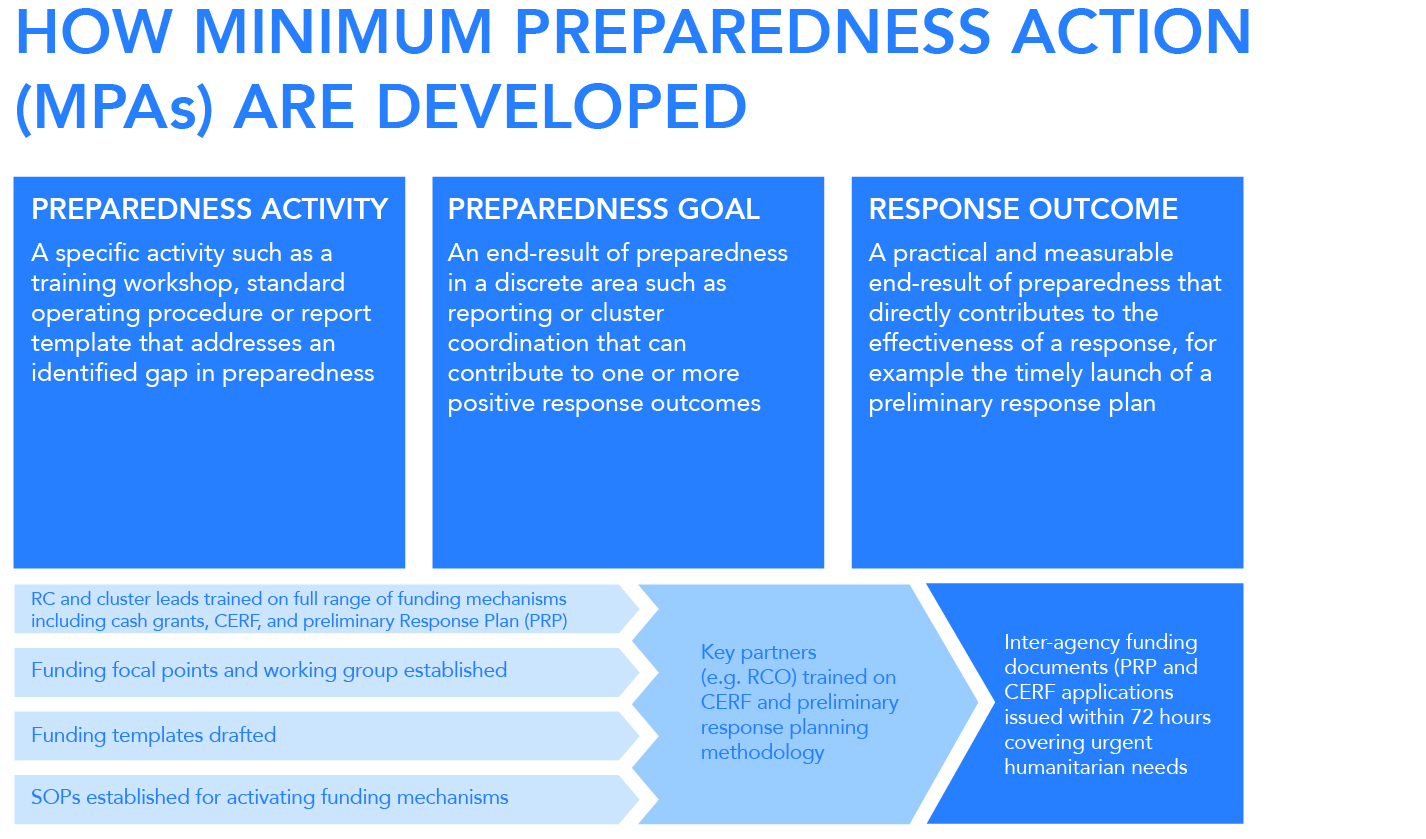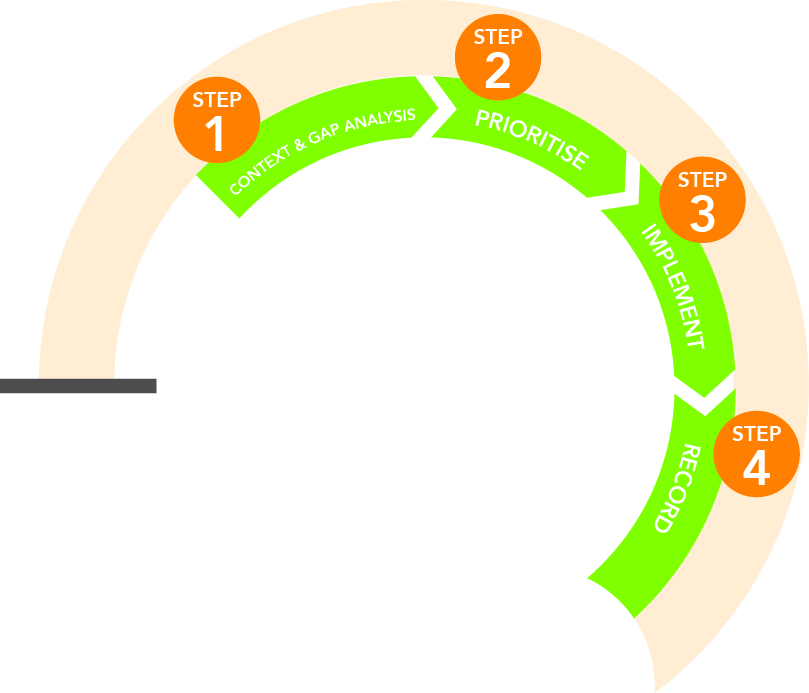Overview
Note. This guidance forms part of the Emergency Response Preparedness (ERP) approach. In its current form, it reflects the "BETA" version of the ERP, which the Inter-Agency Standing Committee (IASC) Task Team on Preparedness and Resilience released for field testing in 2015. The final version of the ERP may look different, once released.
Emergency Response Preparedness (ERP) Minimum Preparedness Actions (MPAs) are a set of activities that every UN Country Team (UNCT) or Humanitarian Country Team (HCT) must implement to establish a minimum level of emergency preparedness within a country. MPAs are not risk or scenario-specific and can usually be accomplished without significant additional resources. They include risk monitoring, establishment of coordination and management arrangements, preparation of joint needs assessments, monitoring, information management, and establishment of operational capacity and arrangements to deliver critical relief assistance and protection. Their implementation makes a fundamental difference to the quality of an eventual response and makes it possible to respond flexibly to different types of emergency.
ERP MPAs are structured along the below categories.
a) Risk monitoring
The MPA checklist outlines key actions that should be taken to ensure that risks are monitored regularly so that preparedness efforts are alert to emerging or developing risks.
b) Coordination and management arrangements
Clearly defined coordination and accountability mechanisms are critical to an effective humanitarian response. A clear understanding of roles and responsibilities enables individuals, teams and organizations to establish working relationships that can make all the difference during a crisis. It is also critical to establish appropriate linkages with Government counterparts and other key partners. MPAs under this section identify key activities for ensuring a coherent coordination system in the event of an emergency.
c) Needs assessment, information management, and response monitoring arrangements
A coordinated needs assessment, that prioritizes the needs of women, men, girls and boys and sub-groups of the population, lays the foundation for a coherent and efficient humanitarian response. It is also critical to establish a system for response monitoring. Response monitoring establishes systems and procedures that measure who receives aid (disaggregated by sex and age), what aid is delivered to them, and what results are achieved. It is underpinned by information management, which is a systematic process of collecting, processing, verifying, and analysing sex- and age- disaggregated data and information, and disseminating relevant information to humanitarian stakeholders, affected populations, and other interested parties. MPAs under this section identify key activities that need to be undertaken ahead of time to ensure these arrangements can be implemented in an emergency.
d) Operational capacity and arrangements to deliver relief and protection
The ability to respond in the immediate aftermath of an emergency depends on the level of operational readiness in place. Experience shows that in most emergencies there is an initial assistance gap because major response operations take on average at least three to four weeks to reach full capacity. Operational preparedness aims to reduce this gap to the extent possible and indicates the minimum level of readiness that should be in place to deliver humanitarian assistance and protection in a principled and accountable manner. This section is aimed primarily at sectors/clusters. The MPA checklist includes actions to identify: the response capacity of sector/cluster partners, including national capacity (Government, local NGOs, and the private sector); the availability and location of critical relief items; and systems for procurement, transportation and distribution of critical relief items.
Key questions
1. Have all relevant actors in the specific cluster/sector been identified, including the private sector, and is their capacity known and mapped?
2. Are all partners aware of the key principles for humanitarian response?
- The centrality of protection.
- Accountability to affected populations, including effective two-way communication with affected communities.
- Humanitarian principles.
- Full mainstreaming of gender equality in humanitarian programmes.
3. Has due consideration been given to the suitable contents of a basic emergency relief package (taking cultural or gender equality implications or preferences into account), including the possible use of cash transfers and vouchers?
4. Have basic supply chain requirements been considered (the location of relief stocks, suppliers, logistics, etc.)?

Relevance for emergency operations
MPAs represent a set of core preparedness activities that need to be undertaken to achieve positive outcomes in the initial emergency response phase. Some MPAs may take longer to implement (understanding local shelter options and practices, for example). Others require more continuous effort (risk monitoring, or updating contact lists). MPAs also promote more effective coordination between humanitarian actors that takes into account the perspective of affected populations through situation (baseline) and needs analysis.
The purpose of MPAs is:
- To establish a standard of minimum emergency preparedness, enabling the UNCT or HCT to maintain and measure its level of response readiness.
- To lay the foundation for a rapid build-up of emergency readiness, should a risk become imminent.
- To reach a level of basic operational readiness, so that it is possible to respond to a sudden-onset emergency.

Main guidance
Underlying process – how does this work?
ERP MPAs are an ongoing set of activities and should be scheduled into the UNCT and/or HCT work plan. It is recommended that MPAs are reviewed and updated at least once a year, or when risk analysis and monitoring indicate an emerging risk, or when there is a significant turnover of core agency staff.
Step 1. Context and gap analysis
As a first step the UNCT or HCT should undertake a gap analysis to establish the current level of preparedness. An ERP process includes key questions (see attached) to guide UNCTs/HCTs as they implement the MPA checklist. These questions assist the UNCT/HCT or sector/cluster to identify and discuss gaps in preparedness. They are designed to gather essential background information and help to identify special requirements and operational constraints.
Step 2. Prioritization
Based on the output of the gap analysis, the UNCT or HCT should prioritise the most pressing MPAs, to be implemented first. All country teams have constraints on their capacity to implement preparedness. It is therefore essential to ensure that the prioritisation process has the backing and buy-in of all those involved in implementing MPAs.
Step 3. Implementation
The UNCT or HCT should develop a work plan to implement the MPAs, based on agreed prioritization. The MPA checklist (see attachment) serves as a guide for this process.
Step 4. Recording actions taken
It is very important to record accountabilities, deadlines and actions, so that the UNCT or HCT can clearly monitor the level of minimum preparedness that has been achieved. The MPA templates (see attachment) can be used for this purpose.

UNHCR’s role and accountabilities
As a member of the UNCT and HCT, UNHCR participates fully in ERP. With respect to preparedness for IDP situations and natural disasters, UNHCR contributes to preparedness efforts led by the RC and/or HC.
ERP is primarily applicable to inter-agency preparedness for natural disasters and internal displacement (IDP) situations. For potential refugee crises (where the identified emergency risk specifically relates to the possibility of a refugee emergency), UNHCR leads preparedness efforts with partners and the Preparedness Package for Refugee Emergencies (PPRE), which uses the same approach as the ERP, should be used as a toolkit and for guidance.
Links
Main contacts
UNHCR Division for Emergency Security and Supply (DESS), Emergency Services. At: [email protected].
In this section:
Let us know what you think of the new site and help us improve your user experience….
Let us know what you think of the new site and help us improve your user experience….
